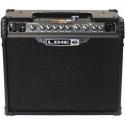What is an Amp Head? How Different is it from a Combo Amp?
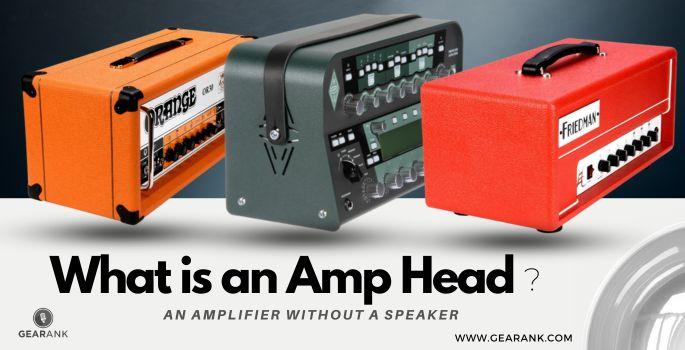
Amplifiers are crucial for live performances as they create powerful sounds.
But what is an amp head? How is it different from a combo amplifier?
In this article, I will explain amp heads, their purpose, and their functionality. I will also show how they contribute to creating a signature sound that many musicians seek.
What is an Amp Head
An amplifier head or a guitar amp head houses the preamp and power amp stage.
It boosts the electrical signals from your playing before sending them to a speaker cabinet.
Its preamp section shapes your sound, while its power amp section amplifies the signal. Boosting it to a level suitable for driving speakers and adding strength to your overall sound.
Amp heads are used in conjunction with a speaker cabinet. This modular design lets players mix and match amp heads with various speaker cabinets to get their desired sound.
What is a Speaker Cabinet
A speaker cabinet or "cab" is an enclosure that houses one or more speakers. The speaker and cabinet work together to project the audible sound generated by the guitar amp head. 4 x 4 guitar cabs are popular speakers for amps, often seen as backdrops on stage.
Enclosures are necessary to prevent rear sound waves from interfering with front waves. They also enhance bass drivers and absorb vibrations from all drivers.
Note: A driver is the mechanical part of a speaker cabinet. Drivers transform the electrical energy.\ of the audio signal into mechanical energy. It is achieved by moving air to generate sound. Different types of drivers: tweeters, super tweeters, woofers, subwoofers, and rotary woofers.
How Does An Amp Head Work With a Speaker Cabinet?
A speaker cable connects the head amp to the speaker cab. These speaker cables have 1/4" jack connections specifically designed to transmit signals. These signals are more powerful than standard jack or instrument cables, which connect an electric guitar to a guitar amplifier.
The pairing of amplifier heads and speaker cabinets is determined by their impedance. Measured in ohms (Ω), impedance refers to the degree of resistance a speaker presents to an incoming signal from the amplifier.
Another thing to consider is the power handling of your cab. For example, if you have a 100-watt amp head, you should use a cab with a power handling of at least 100 watts or more.
What is a Full Stack and Half Stack?
A full stack is an amp head and cab setup that pairs an amp head with two speaker cabinets. Meanwhile, a half-stack cab setup comprises an amp head and a single speaker cabinet.
The advantage of using stacks lies in their ability to deliver higher volume levels and increased low-end response. Amp head cab setups were particularly useful in big stages. But improvements in PA systems have made it easier to project the sound of electric guitars without the need for loud amps.
What are Combo Amps?
A combo amp is what many people refer to when mentioning the word "amplifier."
It is an amp that integrates both amp head and cab functions into one single unit.
This all-in-one amplifier is highly popular among guitarists. With its convenience and portability, combo amps are perfect for small settings and practice sessions.
While combo amps can be practical, they frequently lack adaptability and customization possibilities. Such features are offered by separate amp heads and cab setups.
Different Types of Amps
-
TUBE or VALVE AMP
A tube or valve amplifier uses a glass tube with electrodes to control current flow.
It enhances the guitar input signal and amp tone and drives the speakers.
A tube amp head sounds great even when pushed to its limits. Tube-driven amp heads also have a warmer, thicker tone with a more organic distortion sound. The reason why it is preferred by a lot of electric guitar players.
However, tube amplifiers can be heavy because of their heavy components.
Tube amps are also fragile and may require tube replacement over time due to use or damage caused by aggressive amp handling.
-
SOLID-STATE AMP
Unlike tube amplifiers, solid-state amplifiers are composed of transistor preamp and power sections and are known for not producing pleasant distortion when pushed to their limits.
These are best suited for instruments that do not require distortion, such as bass guitar or keyboard, and are also preferred by jazz guitarists who often play without much overdrive.
Solid-state amplifiers are also generally less expensive and lighter than tube amplifiers. They are frequently more dependable and long-lasting than delicate tube amps.
-
HYBRID AMP
These amps feature an actual tube together with a solid-state power unit. To achieve tube tone without the usage of power tubes. Many hybrid amplifiers combine a tube in the preamp section with solid-state circuitry in the power section.
The main idea behind a hybrid is to give you the best of both worlds. The superb tube sound and distortion with solid-state signal processing and stability.
Amps with hybrid models are available from Orange, Vox, and Line 6.
-
DIGITAL AMP
Modeling amplifiers utilize software to simulate the sounds of various amplifier types and cabinets, allowing them to combine multiple tones into a single device.
This technology allows musicians to replicate tones from different genres and even older music from past decades.
Some modeling amps can also be programmed to adjust settings based on personal tone preferences.
The main advantage of modeling amps is the ability to access a wide range of tones using a single guitar amplifier.
Amp Heads vs Combo Amps
If you're deciding to use or buy one, it's crucial to weigh the advantages and disadvantages of the two amps. Understanding the benefits and drawbacks of each setup will enable you to choose one that best suits your needs and preferences.
Modularity:
-
Amp Head - Using an amp head allows you to select different amp->cab combinations to achieve your desired sound. You can pair the amp head with different speaker cabinets to achieve the tones that you prefer. This also means that you can travel with just the head and use speakers provided by the venues.
-
Combo Amp - A combo amp combines the amplifier and speaker functions in a single unit. It operates without depending on external speaker cabinets. This plug-and-play design is perfect for beginners as it is easier to use.
Tonal Versatility:
-
Amp Head - With amp heads, you have more control over your sound by using a different speaker cabinet. This gives you another avenue of tone control.
-
Combo Amp - unlike amplifier heads, Combo amplifiers have a fixed speaker configuration and they generally have fewer customizing options. You have less freedom to adjust your sound to particular tastes or genres.
Power and Performance:
-
Amp Head - Amp heads can deliver higher wattage ratings in live performances or larger venues. This enables you to achieve louder volumes and better projection.
-
Combo Amp - Combo amplifiers, especially smaller models, may not provide enough power for certain situations or larger venues.
Portability:
-
Amp Head - With the need for a separate speaker cabinet, amp heads are generally not a good option portability-wise. These guitar amps are also typically heavy (especially with larger stack configurations). So, it is not recommended for musicians continuously on the move.
-
Combo Amp - Combo amplifiers, however, are designed with portability in mind. They are light and small in size. Combo amps are also easier to set up, requiring minimal cabling and connections. Making it a useful option if you're a gigging musician who frequently switches between different venues.
Cost:
-
Amp Head - Paired with speaker cabinets, amp heads can be more expensive than a combo amp. The separate parts needed for an amp head setup may strain your finances if you're on a tight budget.
-
Combo Amp - If you're trying to save some cash, a combo amp is an excellent option because it combines the amplifier and speaker in one unit. This makes it more affordable compared to buying them separately.
-
Combo amps are particularly helpful if you're on a limited budget or just starting. You don't have to compromise on sound quality, either.
Venue Size
-
Amp Head - A stack or half-stack configuration can guarantee that your sound effectively reaches the crowd if you're performing in larger spaces or on outdoor stages.
-
Combo Amp - A combo amplifier is usually adequate for smaller settings, like clubs or coffee shops, to provide the required volume and tone. Combo amplifiers are lightweight and practical for small spaces.
Music Genre
-
Amp Head - If you play heavy metal or hard rock, you might prefer the aggressive and potent tone that a stack or half-stack setup produces.
-
Combo Amp - A combo amp or a smaller amp head paired with an appropriate cab can produce a warmer and more vintage-oriented tone. Such a tone is better suited to genres like jazz or blues.
Frequently Asked Questions
Can I Use An Amp Head Without A Speaker Cabinet?
An amp head requires a cab to be able to produce sound. Guitar cabinets are important because they are the ones who convert electrical signals to actual sound. So without them, an amp head typically can't produce sound.
However, some guitar amp heads, like the Boss Katana Head MkII, have built-in speakers. This lets you play with just an amp head without connecting to a separate cab. Making it the perfect amp for practice or playing in small spaces.
Can I Use Different Amp Heads With The Same Speaker Cabinet?
Mix and match different guitar amp heads with the same speaker cab. This allows flexibility and the ability to experiment with different tones and characteristics.
But always consider the power handling and impedance to avoid damaging your amp head or speaker cab.
If you're still unsure about those, I recommend watching this video, as it explains in detail the difference between the two.
Are Stack Configurations Better Than A Combo Amp?
Stack configurations offer higher volume levels and increased low-end response. It can be advantageous in live performances and larger (open) venues. While the smaller, more portable combo amp is perfect for smaller, closed venues.
However, which one is better will depend on the specifics of a performance scenario.
Can An Amp Head Be Paired With A Regular Speaker?
Yes, you can use an amp head and pair it with a different type of speaker cabinet - as long as power and impedance are compatible.
However, you cannot achieve the same quality of tone that you would typically get from pairing it with an actual guitar cabinet.
Are amp heads only for professional musicians?
No, a lot of amateur musicians also use amp heads, despite the fact that professional musicians are frequently seen using them.
The tone quality of amp heads compared to regular amp combos is the main selling point of these guitar amplifiers. The portability of compact lunch box style amp heads have also made them ideal for small venue gigs and home use.
Final Thoughts
So that ends our short guide on what is an amp head.
Now, you understand what an amp head is, how it differs from a combo amp, and why you would want to use it.
Weigh in the advantages and disadvantages of each amp setup.
Understand the benefits and drawbacks of each, and choose the one that best suits your needs and preferences.
Now I recommend to learn about how reamp can be used in your own recording studio setup.
Contributors:
Jerome Arcon - Co-writer




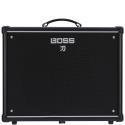
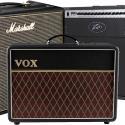
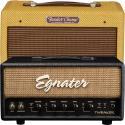 The Best Small / Low Watt Tube Amps - Combo & Amp Heads
The Best Small / Low Watt Tube Amps - Combo & Amp Heads